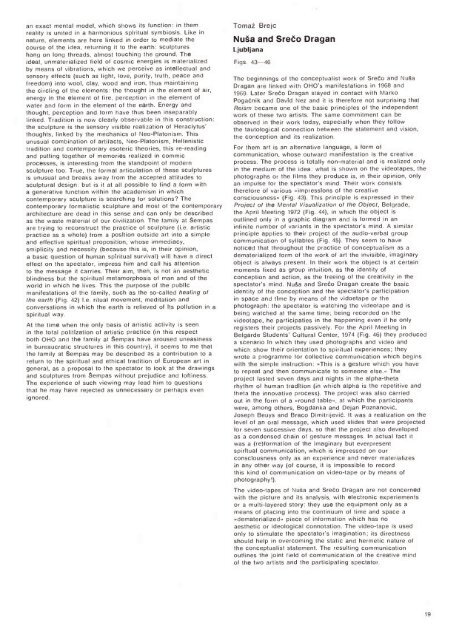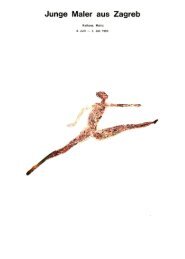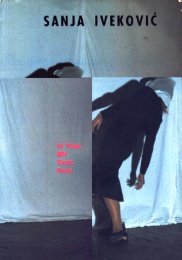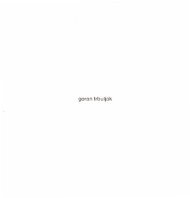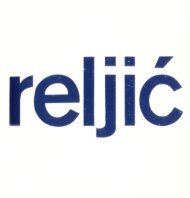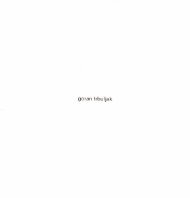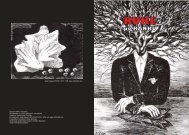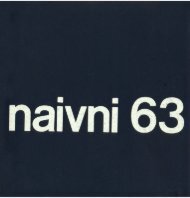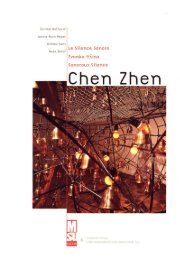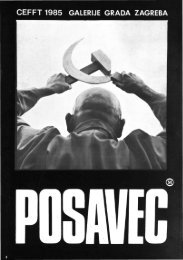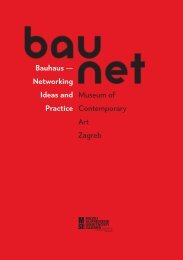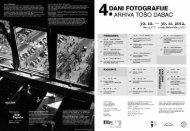The New Art Practice in Yugoslavia, 1966-1978
The New Art Practice in Yugoslavia, 1966-1978
The New Art Practice in Yugoslavia, 1966-1978
- TAGS
- practice
- yugoslavia
- www.msu.hr
You also want an ePaper? Increase the reach of your titles
YUMPU automatically turns print PDFs into web optimized ePapers that Google loves.
an exact mental model, which shows its function: <strong>in</strong> them<br />
reality is united <strong>in</strong> a harmonious spiritual symbiosis. Like <strong>in</strong><br />
nature, elements are here l<strong>in</strong>ked <strong>in</strong> order to mediate the<br />
course of the idea, return<strong>in</strong>g it to the earth: sculptures<br />
hang on long threads, almost touch<strong>in</strong>g the ground. <strong>The</strong><br />
ideal, unmaterialized field of cosmic energies is materialized<br />
by means of vibrations, which we perceive as <strong>in</strong>tellectual and<br />
sensory effects (such as light, love, purity, truth, peace and<br />
freedom) <strong>in</strong>to wool, clay, wood and iron, thus ma<strong>in</strong>ta<strong>in</strong><strong>in</strong>g<br />
the circl<strong>in</strong>g of the elements: the thought <strong>in</strong> the element of air,<br />
energy <strong>in</strong> the element of fire, perception <strong>in</strong> the element of<br />
water and form <strong>in</strong> the element of the earth. Energy and<br />
thought, perception and form have thus been <strong>in</strong>separably<br />
l<strong>in</strong>ked. Tradition is now clearly observable <strong>in</strong> this construction:<br />
the sculpture is the sensory visible realization of Heraclytus'<br />
thoughts, l<strong>in</strong>ked by the mechanics of Neo-Platonism. This<br />
unusual comb<strong>in</strong>ation of artifacts, Neo-Platonism, Hellenistic<br />
tradition and contemporary esoteric theories, this re-read<strong>in</strong>g<br />
and putt<strong>in</strong>g together of memories realized <strong>in</strong> commic<br />
processes, is <strong>in</strong>terest<strong>in</strong>g from the standpo<strong>in</strong>t of modern<br />
sculpture too. True, the formal articulation of these sculptures<br />
is unusual and breaks away from the accepted attitudes to<br />
sculptural design: but is it at all possible to f<strong>in</strong>d a form with<br />
a generative function with<strong>in</strong> the academism <strong>in</strong> which<br />
contemporary sculpture is search<strong>in</strong>g for solutions? <strong>The</strong><br />
contemporary formalistic sculpture and most of the contemporary<br />
architecture are dead <strong>in</strong> this sense and can only be described<br />
as the waste material of our civilization. <strong>The</strong> family at Sempas<br />
are try<strong>in</strong>g to reconstruct the practice of sculpture (i.e. artistic<br />
practice as a whole) from a position outside art <strong>in</strong>to a simple<br />
and effective spiritual proposition, whose immediacy,<br />
smiplicity and necessity (because this is, <strong>in</strong> their op<strong>in</strong>ion,<br />
a basic question of human spiritual survival) will have a direct<br />
effect on the spectator, impress him and call his attention<br />
to the message it carries. <strong>The</strong>ir aim, then, is not an aesthetic<br />
bl<strong>in</strong>dness but the spiritual metamorphosis of man and of the<br />
world <strong>in</strong> which he lives. This the purpose of the public<br />
manifestations of the family, such as the so-called heal<strong>in</strong>g of<br />
the earth (Fig. 42) i.e. ritual movement, meditation and<br />
conversations <strong>in</strong> which the earth is relieved of its pollution <strong>in</strong> a<br />
spiritual way.<br />
At the time when the only basis of artistic activity is seen<br />
<strong>in</strong> the total politization of artistic practice (<strong>in</strong> this respect<br />
both OHO and the family at Sempas have aroused uneas<strong>in</strong>ess<br />
<strong>in</strong> bureaucratic structures <strong>in</strong> this country), it seems to me that<br />
the family at empas may be described as a contribution to a<br />
return to the spiritual and ethical tradition of European art <strong>in</strong><br />
general, as a proposal to the spectator to look at the draw<strong>in</strong>gs<br />
and sculptures from empas without prejudice and loft<strong>in</strong>ess.<br />
<strong>The</strong> experience of such view<strong>in</strong>g may lead him to questions<br />
that he may have rejected as unnecessary or perhaps even<br />
ignored.<br />
Toma Brejc<br />
Nua and Sreo Dragan<br />
jubljana<br />
Figs 43-46<br />
<strong>The</strong> beg<strong>in</strong>n<strong>in</strong>gs of the conceptualist work of Sreo and Nua<br />
Dragan are l<strong>in</strong>ked with OHO's manifestations <strong>in</strong> 1968 and<br />
1969. Later Sreo Dragan stayed <strong>in</strong> contact with Marko<br />
Poganik and David Nez and it is therefore not surpris<strong>in</strong>g that<br />
Reism became one of the basic pr<strong>in</strong>ciples of the <strong>in</strong>dependent<br />
work of these two artists. <strong>The</strong> same commitment can be<br />
observed <strong>in</strong> their work today, especially when they follow<br />
the tautological connection between the statement and vision,<br />
the conception and its realization.<br />
For them art is an alternative language, a form of<br />
communication, whose outward manifestation is the creative<br />
process. <strong>The</strong> process is totally non-material and is realized only<br />
<strong>in</strong> the medium of the idea: what is shown on the videotapes, the<br />
photographs or the films they produce is, <strong>in</strong> their op<strong>in</strong>ion, only<br />
an impulse for the spectator's m<strong>in</strong>d. <strong>The</strong>ir work consists<br />
therefore of various «impressions of the creative<br />
consciousness» (Fig. 43). This pr<strong>in</strong>ciple is expressed <strong>in</strong> their<br />
Project of the Mental Visualization of the Object, Belgrade,<br />
the April Meet<strong>in</strong>g 1972 (Fig. 44), <strong>in</strong> which the object is<br />
outl<strong>in</strong>ed only <strong>in</strong> a graphic diagram and is formed <strong>in</strong> an<br />
<strong>in</strong>f<strong>in</strong>ite number of variants <strong>in</strong> the spectator's m<strong>in</strong>d. A similar<br />
pr<strong>in</strong>ciple applies to their project of the audio-verbal group<br />
communication of syllables (Fig. 45). <strong>The</strong>y seem to have<br />
noticed that throughout the practice of conceptualism as a<br />
dematerialized form of the work of art the <strong>in</strong>visible, imag<strong>in</strong>ary<br />
object is always present. In their work the object is at certa<strong>in</strong><br />
moments fixed as group <strong>in</strong>tuition, as the identity of<br />
conception and action, as the free<strong>in</strong>g of the creativity <strong>in</strong> the<br />
spectator's m<strong>in</strong>d. Nua and Sreo Dragan create the basic<br />
identity of the conception and the spectator's participation<br />
<strong>in</strong> space and time by means of the vidoetape or the<br />
photograph: the spectator is watch<strong>in</strong>g the videotape and is<br />
be<strong>in</strong>g watched at the same time: be<strong>in</strong>g recorded on the<br />
videotape, he participaties <strong>in</strong> the happen<strong>in</strong>g even if he only<br />
registers their projects passively. For the April Meet<strong>in</strong>g <strong>in</strong><br />
Belgarde Students' Cultural Center, 1974 (Fig. 46) they produced<br />
a scenario <strong>in</strong> which they used photographs and video and<br />
which show their orientation to spiritual experiences: they<br />
wrote a programme for collective communication which beg<strong>in</strong>s<br />
with the simple <strong>in</strong>struction: «This is a gesture which you have<br />
to repeat and then communicate to someone else.» <strong>The</strong><br />
project lasted seven days and nights <strong>in</strong> the alpha-theta<br />
rhythm of human tradition (<strong>in</strong> which alpha is the repetitive and<br />
theta the <strong>in</strong>novative process). <strong>The</strong> project was also carried<br />
out <strong>in</strong> the form of a «round table», at which the participants<br />
were, among others, Bogdanka and Dejan Poznanovi,<br />
Joseph Beuys and Braco Dimitrijevi. It was a realization on the<br />
level of an oral message, which used slides that were projected<br />
for seven successive days, so that the project also developed<br />
as a condensed cha<strong>in</strong> of gesture messages. In actual fact it<br />
was a (re)formation of the imag<strong>in</strong>ary but everpresent<br />
spiritual communication, which is impress:ad on our<br />
consciousness only as an experience and never materializes<br />
<strong>in</strong> any other way (of course, it is impossible to record<br />
this k<strong>in</strong>d of communication on video-tape or by means of<br />
photography!).<br />
<strong>The</strong> video-tapes of Nua and Sreo Dragan are not concerned<br />
with the picture and its analysis, with electronic experiements<br />
or a multi-layered story: they use the equipment only as a<br />
means of plac<strong>in</strong>g <strong>in</strong>to the cont<strong>in</strong>uum of time and space a<br />
«dematerialized» piece of <strong>in</strong>formation which has no<br />
aesthetic or ideological connotation. <strong>The</strong> video-tape is used<br />
only to stimulate the spectator's imag<strong>in</strong>ation: its directness<br />
should help <strong>in</strong> overcom<strong>in</strong>g the static and hermetic nature of<br />
the conceptualist statement. <strong>The</strong> result<strong>in</strong>g communication<br />
outl<strong>in</strong>es the jo<strong>in</strong>t field of communication of the creative m<strong>in</strong>d<br />
of the two artists and the participat<strong>in</strong>g spectator.<br />
19


